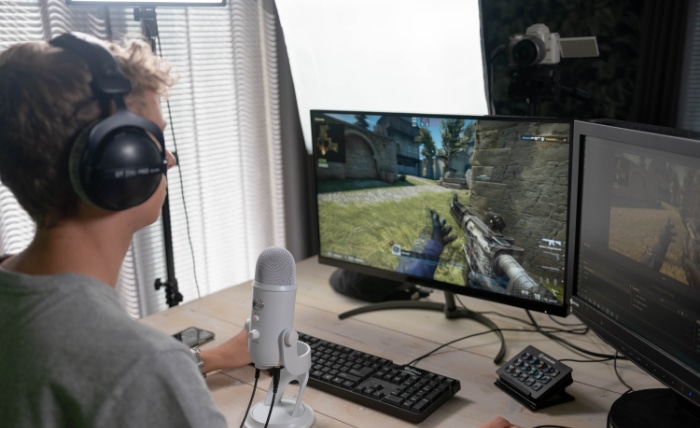How Many Games Can 1TB Hold? Beyond Just Game Files

When it comes to gaming, the importance of ample storage space often takes a backseat to considerations like graphics, speed, and gameplay. However, as games become more complex and expansive, the storage space they occupy is increasingly critical.
Whether you’re a casual gamer or a hardcore enthusiast, you’ve likely pondered how much storage you really need. One of the most common storage capacities is 1TB, but how many games can it actually hold? This question is crucial for optimizing your gaming experience and system performance.
Game File Sizes: The Variable Factor
One of the most significant variables that will determine how many games you can fit on a 1TB hard drive is the file size of the games you wish to install. Game file sizes can vary dramatically based on several factors such as the type of game, its graphical requirements, and the complexity of its code.
Types of Games and Their Average Sizes
AAA Titles
These are blockbuster games with high-quality graphics, elaborate storylines, and extensive gameplay. Due to their complexity, these games can easily require between 50GB to 100GB of storage space.
Examples include “Call of Duty: Modern Warfare,” “Red Dead Redemption 2,” and “Final Fantasy XV.”
Indie Games
Indie games usually have simpler graphics and shorter gameplay compared to AAA titles. Their storage requirements are typically much lower, often ranging from 1GB to 15GB. Examples are “Celeste,” “Hollow Knight,” and “Stardew Valley.”
Mobile Games on PC
Some people prefer to play mobile games on PC using emulators. Mobile games are generally designed to be compact, usually occupying less than 1GB of space. Titles in this category include “Angry Birds” and “Clash Royale.”
Factors Affecting Game File Sizes
Graphical Complexity
High-resolution textures and intricate 3D models consume a lot of disk space. Games that aim for a photorealistic experience will almost always require more storage.
Audio Files
Games with extensive voice acting and high-fidelity soundtracks can also take up a considerable amount of space. This is especially true for games that offer multiple language options.
Additional Content
Post-release additional content, such as downloadable skins, new characters, or extra levels, can further increase the storage space needed for a game.
Real-world Examples of Game Sizes
To give you a practical perspective, let’s look at some examples of popular games and their file sizes:
- “Call of Duty: Modern Warfare” – Approximately 90GB
- “The Witcher 3: Wild Hunt” – Around 40GB without DLC
- “Minecraft” – Roughly 1GB, though it can increase with mods and updates
- “Stardew Valley” – About 500MB
The Cumulative Effect
If we were to install all the aforementioned examples simultaneously, they would require around 132GB of storage space. Considering that a 1TB drive actually provides about 931GB of usable storage (accounting for system files and formatting), you could theoretically fit a mix of about 7 AAA titles along with several indie games and mobile titles.
Updates and DLCs: The Hidden Storage Eaters
When calculating how many games a 1TB storage can hold, many people overlook the additional space needed for updates and downloadable content (DLC). These can significantly increase the storage footprint of your games, sometimes almost doubling the original size.
The Impact of Game Updates
Routine Updates
Games frequently release patches and updates to fix bugs, enhance performance, or introduce new features. These updates can range from a few megabytes to tens of gigabytes.
For instance, some updates for AAA titles like “Call of Duty: Warzone” have been known to require up to 20GB or more.
Seasonal and Event-Based Updates
Special events, such as holiday-themed updates or seasonal content releases, often add extra gigabytes to the game’s storage footprint. These can be temporary but still require free space for installation.
DLCs and Expansion Packs
Types of DLC
From story extensions and new missions to additional characters and cosmetic items, DLCs come in various forms. They offer new content that extends the life of a game but also requires more storage space.
Storage Requirements
Some DLCs can be quite small, adding just a couple of GBs to the total size. However, larger expansion packs can demand much more, sometimes up to 30GB or even 50GB for expansive story add-ons.
Other Forms of Additional Content
Modding Communities
Games with active modding communities offer player-created content that can consume substantial amounts of storage, depending on the complexity of the mods.
Microtransactions and In-Game Purchases
Although not as space-consuming as other forms of additional content, in-game purchases like new outfits or equipment might still add small increments to the storage requirements.
Real-World Examples of Update and DLC Sizes
- “The Elder Scrolls V: Skyrim” – Original size around 12GB, but with all DLCs and updates, it can go up to 30GB.
- “Destiny 2” – Starts at about 90GB but can exceed 150GB with all updates and expansions.
- “Fortnite” – Initial download is roughly 17GB, but frequent updates can push it beyond 40GB.
Things to Consider
While it might be tempting to fill up your 1TB storage with as many games as it can hold, remember to leave room for these hidden storage eaters. A good rule of thumb is to keep at least 20% of your disk space free to accommodate future updates, DLCs, and other additional content.
This ensures you won’t have to go through the hassle of constantly deleting and reinstalling games to make room for new content.
Additional Storage Needs: Cache, Save Files, and More

Besides the actual game files, updates, and DLCs, there are other elements that require storage on your system. These include cache files, save files, screenshots, and videos, among others.
While these files may seem negligible compared to the size of modern games, they can accumulate and become substantial over time.
Cache Files and Temporary Data
What Are Cache Files?
Cache files are temporary data stored by the game to speed up load times and improve performance. This includes textures, assets, and sometimes even level data.
How Much Space Is Required?
Typically, cache files may take up anywhere from a few hundred megabytes to a couple of gigabytes depending on the game and its complexity.
Save Files and Game States
The Importance of Save Files
Save files record your progress in a game. They are crucial for games that involve multiple levels, complex storylines, or character development.
Space Requirements
Save files are usually small, often ranging from a few kilobytes to megabytes. However, if you have multiple save states or if the game autosaves frequently, this can add up.
Screenshots and Game Clips
Capturing Moments
Many gamers like to take screenshots or record clips of their gameplay. This is especially popular in open-world games or games with stunning graphics.
Storage Consumption
Screenshots are generally small, but videos can be quite large, sometimes taking up a few gigabytes, especially if recorded in high resolution.
Configuration and Preference Files
Custom Settings
Most games allow you to customize settings like controls, graphics, and audio. These preferences are saved in configuration files.
Storage Impact
These files are relatively small, often just a few kilobytes, but they are essential for a personalized gaming experience.
Real-World Examples of Additional Storage Needs
- A month of gameplay in “World of Warcraft” might generate around 1-2GB of cache data.
- A single “Cyberpunk 2077” save file can be about 8MB, but having multiple saves can significantly increase this number.
- Recording a 10-minute game clip at 1080p can take up to 1.5GB of storage.
Strategies for Storage Management
The seemingly simple question of how many games a 1TB storage drive can hold quickly unravels into a complex issue when considering game sizes, updates, DLCs, and other additional storage needs. Efficiently managing this storage becomes crucial for a hassle-free gaming experience.
Prioritize and Sort Games
Regularly Played vs. Occasionally Played
Differentiating between games you play regularly and those you only touch occasionally can help you decide which ones should remain installed. Keep your frequently played games on the main drive for quick access, while the others can be archived or uninstalled.
Offload Older Games
Consider offloading games that you have already completed or haven’t played for an extended period. They can always be reinstalled when needed.
Use an External Drive for Overflow
Benefits of External Storage
An external hard drive can serve as additional storage for games that don’t fit in the internal 1TB drive. It can also be useful for archiving older games that you may want to revisit in the future.
Types of External Drives
Solid-state drives (SSDs) offer faster load times and data transfer but are more expensive. Traditional hard disk drives (HDDs) provide more storage at a lower cost but are slower.
Optimize In-game Settings
Reduce Extra Data
Some games allow you to download additional data for enhanced graphics or additional content. If storage is a concern, opt for the minimal download packages to save space.
Manage Cache Settings
Certain games permit you to control how much cache they use. Lowering these settings can free up disk space but might impact game performance.
Manual Cleanup and Maintenance
Periodic Checks
Regularly review your storage situation to identify opportunities for optimization. Delete obsolete save files, clear out cache, and consider uninstalling games you no longer play.
Use Built-in or Third-Party Tools
Many operating systems come with built-in storage management tools that can help you visualize your storage usage. Additionally, there are third-party applications designed for gamers that assist in managing game files efficiently.
Contingency for New Releases
Always leave some free storage space for upcoming game releases or unanticipated large updates. A good rule of thumb is to maintain at least 50GB of free space to accommodate new content.
Conclusion
Balancing the myriad factors that contribute to storage needs on a 1TB drive presents both challenges and opportunities for avid gamers. From game file sizes and hidden storage eaters like updates and DLCs, to additional necessities such as cache and save files, it’s evident that managing storage is far from straightforward.
Adopting a proactive approach by prioritizing games, considering external and cloud storage, optimizing settings, and performing regular maintenance can go a long way in ensuring a seamless gaming experience. By being mindful of these aspects, you can fully leverage the capabilities of your 1TB storage drive, allowing for a more enjoyable and less restrictive gaming environment.


